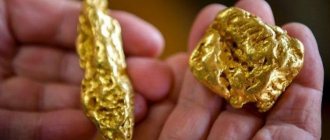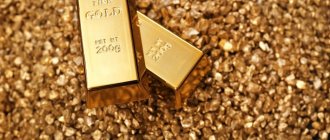Gold mining is a global business, operating on every continent except Antarctica. And gold mining in Bashkiria occupies a significant part in this area.
Long before any gold is obtained, extensive research and measurements will be required. To determine the size of the deposit as accurately as possible, and to extract and process gold ore efficiently and safely.
It will take an average of 10-20 years before a mine is ready to produce material.
Sources of gold in the Urals
In areas of the Urals, huge volumes of precious rocks are mined every year. They account for about 15 percent of total production. It is one of the richest sources of precious metals. And gold too.
This is due to the following:
- features of the geographical location;
- moderate climate type;
- resource location availability;
- absence of permafrost in the spring.
Currently, gold mining is carried out throughout the Ural territory.
The year 1745 is considered to be the beginning of the official operation of gold-bearing mines. However, many people previously discovered Ural gold nuggets and sold them.
So, briefly about where and how they look for gold in the Urals.
Although, as noted earlier, gold mining is currently carried out everywhere, Chelyabinsk and Sverdlovsk stand out from all places. They are famous for their rich sources of precious metals, which have not yet been exhausted.
| Chelyabinsk region | 49,7% |
| Republic of Bashkortostan | 34,9% |
| Orenburg region | 15,4% |
Rating of regions of the Southern Urals for gold mining. Data for 2016.
Every year, 20-50 tons of gold are obtained on the Ural side. Extraction is carried out in several ways:
- Manually. Specialists wash the sand themselves and then sift it.
- Ore method. Such work is usually carried out in mines.
- Using dredge. A dredge is a special machine used for washing soil.
- Hydraulic method. Workers use a special pump that erodes rocks.
As a rule, in most cases the ore method is used. It is the most convenient and is actively used throughout Russian territory.
The mine with large gold reserves, which was discovered first, was precisely the Ural mine. And it was called “Berezovsky”. This happened in 1747 near the Berezovka river, which flows near Yekaterinburg. A little 9-year-old girl discovered gold flecks while playing in the sand. This is how it became known about one of the largest deposits.
This mine with a 300-year history still exists today. Its area has been completely explored by gold miners, although it extends for tens of kilometers.
Many experts argue that the Ural gold reserves are far from exhausted. According to research, gold mining in the Urals will continue to exist for about a century. At the same time, the projected amount of gold mined is at least 20 tons annually.
In addition, they are now actively exploring hard-to-reach places where miners have never set foot before. Many of them contain gold and other precious rocks.
Geography of gold mining and a little history
For the first time, humanity began to find gold where ancient civilizations had already settled, for example, in northern Africa, India, Mesopotamia and the Mediterranean. Not long ago, scientists tried to calculate how much gold people managed to extract throughout history. The figure is truly enormous: over one hundred thousand tons.
The ancient world sourced its gold from Egypt, which believed its supply was endless. Sudan kept pace with Egyptian gold mining and also produced large volumes of pure gold. In third place it is worth noting Africa, which, for certain reasons, transported all the gold mined to Egypt.
Gold mining sites in Ancient Egypt.
If we talk about the Middle Ages, then gold production was the lowest in the entire history of mankind.
After America was discovered, world gold reserves began to increase sharply, since this country has always been rich in its deposits. Central America has taken first place in the world in reserves of precious metals.
As you know, gold is a finite resource. Therefore, it is not surprising that the geography of gold deposits changes from year to year. And these changes are often quite radical.
For example, let's take the 80s, when world gold reserves were replenished by more than 940 tons. The majority of all these reserves were mined in South Africa, specifically 675 tons. And so it was for ten years. By the beginning of the 2000s, the main mining sites moved to Latin America, while gold production in South Africa began to decrease by 35%.
Australia has always been full of gold deposits and has always tried not to be inferior to the “golden” powers, each time finding more and more new mines in its depths.
Gold mining in Bashkiria
At the Russian level, Bashkiria is one of the largest gold producers. Thus, in 2015, approximately 7.5 tons of precious metals were mined on Bashkir territory, among which gold was not the least important.
On the territory of Bashkortostan there are four main regions where gold has been mined for a long time. All deposits have differences in the nature and composition of the metal mined there:
- Sakmaro-Tanalyk zone – placers;
- The Uchalinsky district is predominantly a gold-sulfide deposit;
- Baymaksky district - this area is characterized by gold and polymetallic mining;
- Beloretsky district. In the Uchalinsky and Baymaksky districts there is the largest concentration of quartz gold veins.
And throughout the east of the South Ural slope, gold-quartz compositions are dispersed. A certain number of them are also present in the areas of Upper Avzyan.
Most of the Trans-Ural deposits with sulfide ore are high-quality sources of both gold and copper.
The large concentration of precious deposits in Bashkiria is due to the number of oxidation zones in the deposits. Currently, geological work and the search for new gold deposits are being actively carried out in Bashkortostan. A number of potential rich sources have already been found.
Recently, private gold mining in abandoned mines was legalized here. Absolutely anyone can come here with a metal detector and start searching. True, the likelihood of finding something is small. Because these places have been walked far and wide by professionals a long time ago.
Gold mining in Magadan
According to calculations and preliminary analysis of gold deposits, reserves of precious metal deposits in Kolyma amount to 2-3 thousand tons. Also, about 450 tons of placer and native gold throughout the Magadan region awaits development in smaller deposits.
The precious metal is extracted here by more than 150 mining enterprises, of which 130 develop gold deposits of placer gold. By production volume
Magadan occupies a leading position in Russia . The annual production here is about 16 tons.
In 2021, mines in Kolyma increased production to 37 tons: primary gold - 20 tons, and alluvial gold - 17 tons.
The main gold mining companies in Kolyma:
- JSC "Polyus" - Natalka field.
- JSC "Pavlik" is a deposit of the same name.
- JSC Susumanzoloto is a mining enterprise specializing in the development of placer gold deposits. The gold mines of this enterprise yield about 5 tons annually.
- in 2021, it developed several large deposits and produced 2.5 tons of gold.
At the end of 2021, over 40 tons of gold were mined in the Magadan region.
Gold mining in the rivers of Bashkiria
Many deposits can be found near river waters. With sufficient awareness, it is possible to find a placer even in shallow water.
There are many rivers in Bashkiria that contain gold.
Rivers play a significant role in the gold mining industry of Bashkiria.
Before starting the mining itself, experts examine the components of the bottom, since gold is not found in every river section.
The presence of metal also depends on the nature of the soil. Hydrologists are dealing with this issue. Often gold deposits can be found in dry river beds. In the form of sediment.
Some of the former river flow sediments may also contain gold. The richest deposits in this regard are:
- alluvial and channel;
- terrace and bottom.
Before they start looking for gold, miners study all kinds of data. Such as the reasons for the appearance of metal in the soil and the nature of its movements.
Due to the fact that metal is several times heavier than water, it is easy to calculate its movements. The stronger the water flow, the greater the likelihood of resource displacement. Distance and direction are calculated in the same way.
However, gold rarely travels long distances. Unless it's just a gold mine. Nuggets, especially large ones, simply crawl along the bottom surface in the direction of the current. Due to the weight of the nugget and the law of attraction, the speed of movement is minimal.
In the vast majority of situations, the placer occurs either at the end of a bend in the river channel or at the beginning. There is also a high chance of encountering gold in the inner river bend.
Mindyak: abandoned mines
A gravel road provides easy access to one of Mindyak's . This gray cube is visible already at the entrance to Mindyak on the left.
You can look into the building:
There are also many abandoned buildings around the mine:
Geology of placer deposits
A placer deposit is a concentration of natural gold accumulated in sediments. For example, in the beds of rivers and streams.
Gold produced by weathering or another process is likely to accumulate in placer deposits because of its light weight and corrosion resistance. In addition, its characteristic yellow color makes it easily and quickly recognizable even in very small quantities.
To extract gold of this type, special miner's trays and sieves are often used. They are a container made of sheet iron with sloping sides and a flat bottom, which is used for washing gold-bearing soil or other material containing heavy minerals. The alluvium is carefully sifted for valuable materials.
The material washing process is the simplest and most commonly used. This is a less expensive method of separating gold from silt, sand, and other stream sediments.
It's tedious work. And only with practice does a person become a professional in his activity.
Hydrogeochemical exploration
Groundwater may also contain subsurface deposits. As groundwater flows through the deposit, small amounts of gold are washed out of the rocks. Sometimes it can be found in parts of groundwater collected from wells.
Over the past few centuries, Bashkiria has been carefully explored by enthusiasts. They searched for precious metals in both the most famous areas and the little-known ones. The results of their activities have never been fully documented.
But incomplete data suggests that only a few of the many thousands who searched this or that part of the deposits ever found valuable resources. Most of the "golden" areas were explored by industry pioneers, many of whom were very experienced in their field. Therefore, gold ore is rare there.
However, the development of new, highly sensitive and relatively inexpensive gold prospecting methods has greatly expanded the possibility of detecting deposits. Now gold extraction is possible in inaccessible places.
They can be quite large. And therefore suitable for the operation of modern mining and metallurgical plants. Geologists and engineers who explore remote Bashkir regions systematically find small placers of gold.
conclusions
Gold excavations occur every day all over the world. Entire mines and mines are full of minerals that will help the economy of any country reach a new level or stabilize its position. Detailed studies of the area where they plan to take place will always tell you where to look for gold.
In Russia, gold is mined in many regions. And year after year, gold production increases several times, which allows our country to maintain and increase its gold reserves. Private reserves of gold and precious stones are reaching unprecedented heights.
To the question of where a metal such as gold can be mined in Russia, the most correct answer would be - in the Urals. It is there that the largest part of gold is mined compared to other regions. In addition, as you understood from the article, there are plenty of other places where such a noble metal as gold is mined. As a rule, this is the Asian part of Russia.
Facts from the “golden” history of Bashkiria
The vast majority of the world's gold was mined in the modern post-war era. It is not known for certain how many centuries gold mining was carried out in the Southern Urals. But we can definitely say that it manifested itself at the end of the 18th century.
In the Uchalinsky district, even before revolutionary times, a large gold bar was somehow discovered, which weighed about 16 kg. And, after some period, they found another one - weighing 5 kg. He was given the name “Irndyk Bear” and placed in the local central museum. It is still possible to visually study it and even touch it today.
At the end of May 1812, the monopoly on the extraction of this metal was abolished. And all residents of Russia were allowed to search for gold ores. With the condition of further payment to the treasury. Until 26 of the same century, precious metals were mined by miners.
In the south of the Urals they used a chemical method for extracting gold. This happened in 86 of the 19th century, when a plant for processing ephels containing gold was built at one of the mines. The chlorination method was used.
In the period from 1832 to 1917, more than 42 tons of gold were extracted from the subsoil located in Bashkiria. About 28 tons mined occurred between 1885 and 1917. According to scientists, this clearly shows the cyclical nature of the gold mining industry and its dependence on economic and political factors.
By the 20th century, the industry had reached new heights. And this is precisely what contributed to the emergence of the socialist economy some time after the Civil War. It also improved industry throughout the republic.
In the first Soviet years, Buribayevskoye, Sibayskoye, Vostochno-Kuznechnoye and other well-known deposits were discovered. And in the east of the Uchalinsky district they discovered Blagodatnoye, Yuzhno-Remezovskoye and Krasnoohtinskoye.
Mindyak Mining and Processing Plant
The Mindyaksky mining and processing plant is no longer functioning. The photo shows the remains of its former grandeur.
It's hard to believe that people once worked here.
Tons of concrete, masonry, metal structures, but the buildings don't seem very durable. Walking here is dangerous.










